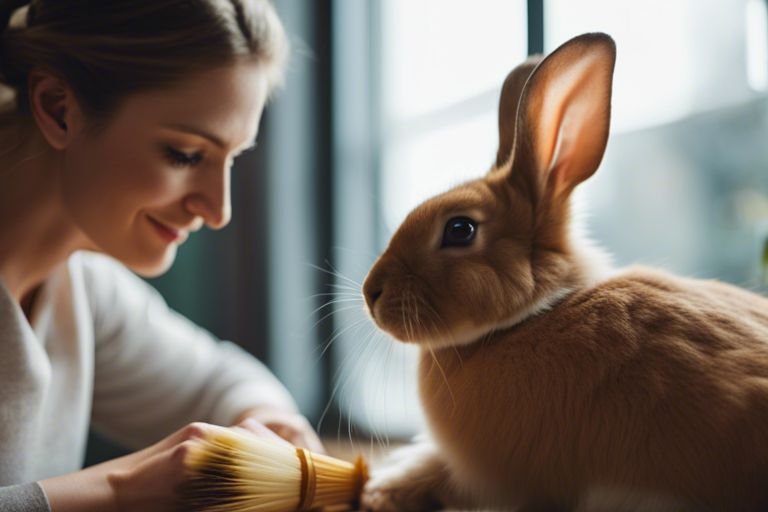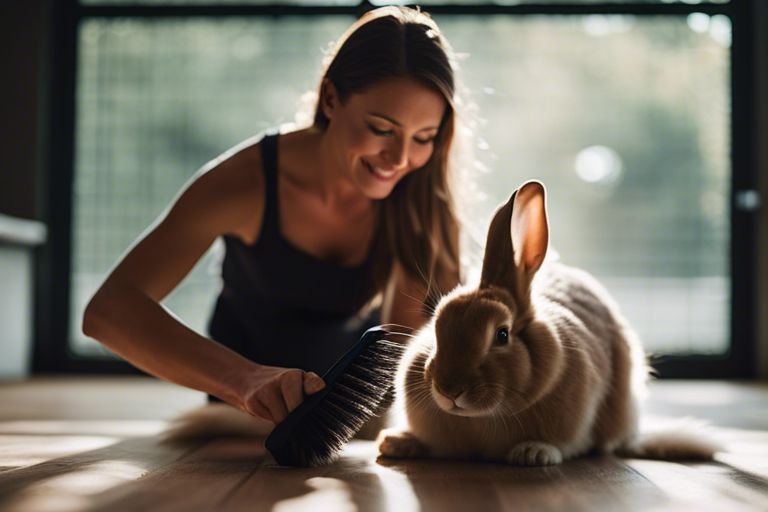Do you own a majestic Flemish Giant rabbit and struggle with hairballs? Fear not, as we have the perfect grooming routine to help reduce hairballs and keep your furry friend healthy and happy. Grooming a Flemish Giant is essential for their overall well-being and to prevent potentially fatal hairball blockages. Regular brushing and grooming can also help reduce shedding and keep your rabbit’s coat in optimal condition. In this blog post, we will cover the best grooming techniques and tips to help keep your Flemish Giant rabbit hairball-free.
Key Takeaways:
- Regular grooming is essential: Groom your Flemish Giant at least once a week to reduce the formation of hairballs. This will help to remove loose fur and prevent it from being ingested by your rabbit.
- Invest in a good quality brush: Use a brush with soft bristles to gently remove loose fur and prevent matting. Avoid using tools with sharp edges that could potentially hurt your rabbit’s delicate skin.
- Provide a balanced diet: Offer a diet rich in fiber, such as hay and leafy greens, to help aid in digestion and prevent the formation of hairballs in your Flemish Giant.
- Ensure proper hydration: Always provide access to fresh water to keep your rabbit hydrated, which can also help facilitate the passage of hair through the digestive system and reduce the risk of hairball formation.
- Monitor your rabbit’s behavior: Keep an eye out for any signs of hairball-related discomfort, such as loss of appetite, lethargy, or frequent grooming. If you notice any abnormal behavior, consult a veterinarian for further guidance.

Understanding Your Flemish Giant’s Coat
Any responsible pet owner knows the importance of understanding and caring for their pet’s coat. This is especially true for owners of Flemish Giants, who have a distinctive coat that requires special attention. If you’re looking for a comprehensive guide on caring for your Flemish Giant, check out the Top 5 Flemish Giant Rabbit Care Guide: Free Tips for Raising for valuable insights.
Characteristics of Flemish Giant Fur
Flemish Giants are known for their dense, soft fur that requires regular grooming to prevent hairballs and matting. Their coat consists of two layers – a dense, soft undercoat and longer, coarser guard hairs. This combination makes their fur prone to tangling and shedding, making regular grooming a necessity to maintain their coat’s health and appearance.
Typical Shedding Patterns
For Flemish Giants, shedding occurs year-round, with heavier shedding during the spring and fall. During these times, it’s not uncommon for owners to notice an increase in hair around the house and on their rabbit’s coat. It’s important to be proactive during these periods and increase grooming frequency to prevent matting and hairballs. Regular brushing and grooming can help control the amount of loose fur and reduce the risk of hairballs in your Flemish Giant.
It’s essential to monitor your Flemish Giant’s shedding patterns and adjust your grooming routine accordingly. This will help maintain the health and appearance of their coat, while also reducing the risk of hairballs and other grooming-related issues.

Essential Grooming Tools and Techniques
Even though Flemish Giants are low-maintenance when it comes to grooming, it’s essential to have the right tools and techniques in place to reduce the risk of hairballs. With the proper grooming routine, you can keep your beloved pet’s coat in great condition and minimize the chances of hairballs causing health issues.
Choosing the Right Grooming Tools
Tools play a crucial role in grooming your Flemish Giant. The most essential tools include a soft brush, a shedding tool, a nail trimmer, and a flea comb. When selecting these tools, look for gentle bristles and quality construction to ensure they are suitable for your rabbit’s delicate skin and thick fur.
It’s also important to invest in a high-quality nail trimmer that is specifically designed for small animals. Keeping your Flemish Giant’s nails at an appropriate length is crucial to avoid discomfort and potential health issues.
Step-by-Step Grooming Process
Right grooming techniques are the key to effectively managing your Flemish Giant’s coat and minimizing the risk of hairballs. Here is a breakdown of the step-by-step process:
| Step 1 | Begin by gently brushing your rabbit’s coat, starting from the head and working your way down to the tail. This helps remove loose fur and prevents matting. |
| Step 2 | Use a shedding tool to manage your rabbit’s seasonal shedding. Be gentle and avoid going over the same spot too many times to prevent skin irritation. |
| Step 3 | Inspect your rabbit’s nails and trim them if necessary. Be cautious and avoid cutting the quick to prevent bleeding and discomfort for your pet. |
Grooming your Flemish Giant regularly using the right tools and techniques is vital in maintaining a healthy coat and reducing the risk of hairballs. It also provides an opportunity for bonding and trust-building between you and your pet. Proper grooming will keep your Flemish Giant happy, healthy, and free from the discomfort of hairballs.
Dietary Considerations for Hairball Reduction
Keep your Flemish Giant’s diet in mind when trying to reduce hairballs. A proper diet plays a crucial role in preventing hairballs and ensuring the overall health of your beloved pet. By paying attention to their food intake, you can significantly decrease the frequency of hairballs.
Importance of Fiber in Your Flemish Giant’s Diet
For your Flemish Giant, fiber is an essential component of their diet when it comes to preventing hairballs. By providing adequate amounts of hay and fresh greens, you can promote regular digestion and keep their gastrointestinal system functioning smoothly. The fiber acts as a natural abrasive, helping to push hair through the digestive tract and prevent it from clumping together and forming hairballs.
Supplements and Treats to Aid Hairball Prevention
Hairball supplements and treats can be an effective addition to your Flemish Giant’s diet. Look for products specifically formulated to aid in hairball prevention, such as those containing natural ingredients like psyllium husk or malt. These supplements and treats can help with hairball elimination and ensure that your rabbit’s digestive system stays healthy.
With the right dietary considerations, including sufficient fiber and the addition of hairball prevention supplements and treats, you can significantly reduce the occurrence of hairballs in your Flemish Giant, promoting their overall well-being and happiness.
Creating a Grooming Routine
Unlike smaller rabbit breeds, Flemish Giants require regular grooming to prevent hairballs. Establishing a grooming routine is essential in keeping your rabbit healthy and comfortable. It also helps reduce the amount of fur they ingest, ultimately minimizing hairball formation.
Frequency of Grooming Sessions
Frequency of grooming sessions may vary depending on your rabbit’s shedding cycle and the length of their fur. In general, it is recommended to groom your Flemish Giant at least twice a week during heavy shedding periods, and once a week during normal shedding cycles. This consistent schedule helps to prevent matting and excessive hair ingestion, which are common causes of hairballs.
Monitoring Your Rabbit’s Hairball Symptoms
To prevent hairballs, it’s crucial to monitor your rabbit’s behavior and physical symptoms regularly. Look for signs such as reduced appetite, lethargy, and a change in bowel movements. Additionally, excessive grooming, coughing, and visible discomfort can indicate that your rabbit may be experiencing hairball-related issues.
The importance of monitoring your rabbit’s hairball symptoms cannot be overstated, as early detection can prevent more serious digestive complications. Pay close attention to any changes in your rabbit’s behavior, and consult a veterinarian if you notice any concerning symptoms. Regular grooming and monitoring are key components of preventing hairball-related health issues in Flemish Giants.
FAQ
Q: How often should I groom my Flemish Giant to reduce hairballs?
A: It is recommended to groom your Flemish Giant at least once a week to reduce the likelihood of hairballs. Regular grooming helps remove loose hair and prevent it from being ingested, leading to fewer hairballs.
Q: What grooming tools should I use for my Flemish Giant?
A: For grooming your Flemish Giant, it is best to use a slicker brush or a grooming glove to remove loose fur. Additionally, a wide-toothed comb can help detangle any mats in the fur. Be sure to use gentle, but firm strokes to avoid causing discomfort to your pet while grooming.
Q: Are there any specific grooming techniques to reduce hairballs in Flemish Giants?
A: When grooming your Flemish Giant, pay special attention to areas where hair tends to mat, such as behind the ears and under the chin. It is also important to check and trim their nails regularly, as overgrown nails can lead to discomfort and a reduction in grooming behavior, which can result in more hairballs. Additionally, providing a high-fiber diet and ensuring your rabbit has plenty of fresh water can help reduce hairballs.
